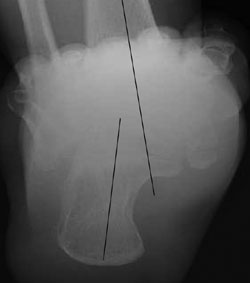X-ray parameters helpful in selecting adults with acquired flatfoot deformity for MDCO
Most patients with stage 2 adult-acquired flatfoot deformity who underwent a corrective medial displacement calcaneal osteotomy had good subjective scores at mid- to long-term follow-up in a retrospective
study, yet the procedure effectively maintained initial correction in only a select group of patients.
“Medial displacement calcaneal osteotomy has only a limited effect on deformity correction. These results should help in planning proper treatment,” Hisateru Niki, MD, of Kanagawa, Japan, said.
He presented the study’s results at the 2010 Annual Meeting of the American Academy of Orthopaedic Surgeons in New Orleans.
|
Image: Niki H |
Using medial displacement calcaneal osteotomy (MDCO), Niki and colleagues treated 31 feet in 30 patients, 28 women, 2 men, aged 42- to 71-years-old, who suffered from stage 2 adult-acquired flatfoot deformity due to tibial tendon dysfunction. They used the technique described by Mark S. Myerson, MD, to perform the osteotomy in combination with a flexor digitorum longus transfer to achieve ligamentous repair.
Investigators determined the patients’ outcomes using on the Japanese Society for Surgery of the Foot (JSSF), foot function index and SF-36 scores, as well as based on changes in eight weight-bearing radiographic measurements of the foot they obtained from anteroposterior, lateral and hindfoot coronal views. They took the measurements pre- and postoperatively at 3, 6 9, and 12 months and every 6 months thereafter.
All physical examinations included the single heel-raise test.
Based on the statistical analysis of differences in the clinical scores and radiographic measurements using the paired t-test and repeated-measures ANOVA, results were worse with the technique in cases that involved preoperative deformity of 15° to 25° or more, he noted.
“The JSSF scores significantly improved from 58 to 90 points … [which] showed most of the patients reported highly satisfactory walking ability,” Niki said. However, only the talonavicular-coverage, lateral talometatarsal angle and hindfoot-coronal-alignment angle X-ray parameters significantly improved and showed maintenance of the correction after surgery, he said.
Investigators concluded the technique is best indicated for patients whose preoperative lateral talometatarsal angles are less than 25° with preoperative hindfoot coronal alignment that is less than 15°.
“The obvious weakness of this study was its retrospective design,” Niki said. He noted during his presentation that the study lacked comparative data and measurements from the patients’ unaffected contralateral sides, which may have been helpful to the analysis. — by Susan M. Rapp
Reference:
- Niki H, Hirano T, Okada H, et al. X-ray indications for medial displacement calcaneal osteotomy (MDCO) for adult-acquired flatfoot. Paper #710. Presented at the 2010 Annual Meeting of the American Academy of Orthopaedic Surgeons. March 9-13, 2010. New Orleans.
- Hisateru Niki, MD, can be reached at the Department of Orthopaedic Surgery, St. Marianna University School of Medicine, 2-16-1 Sugao, Miyamae-ku, Kawasaki, Kanagawa 216-8511, Japan; 81-44-977-8111; e-mail: h2niki@marianna-u.ac.jp.

